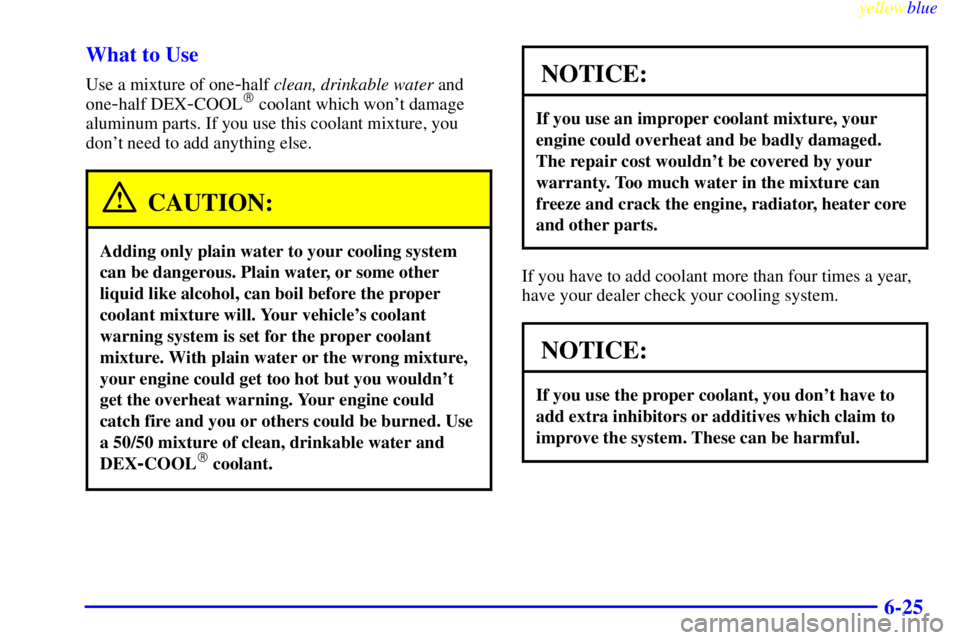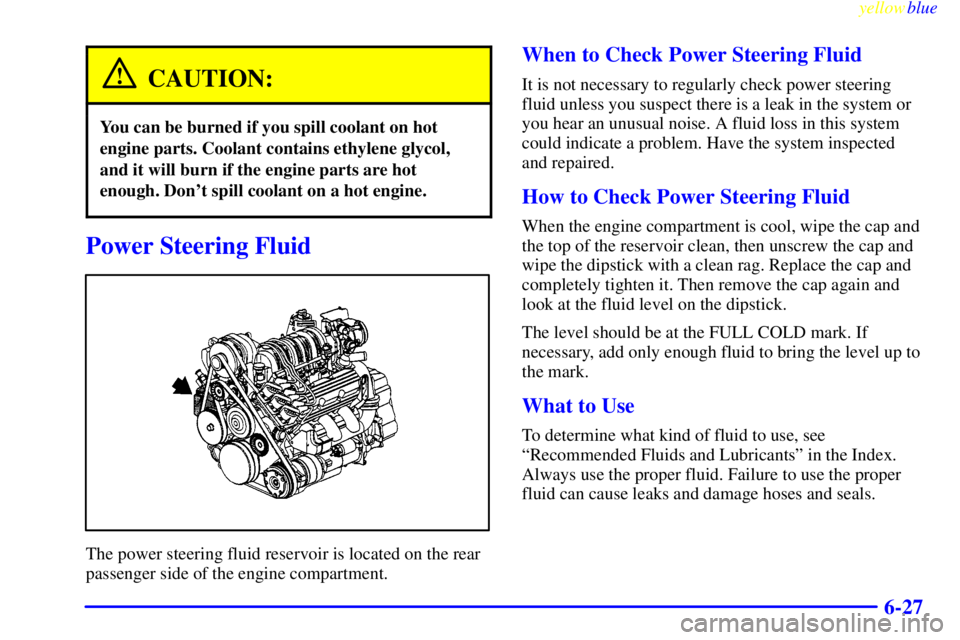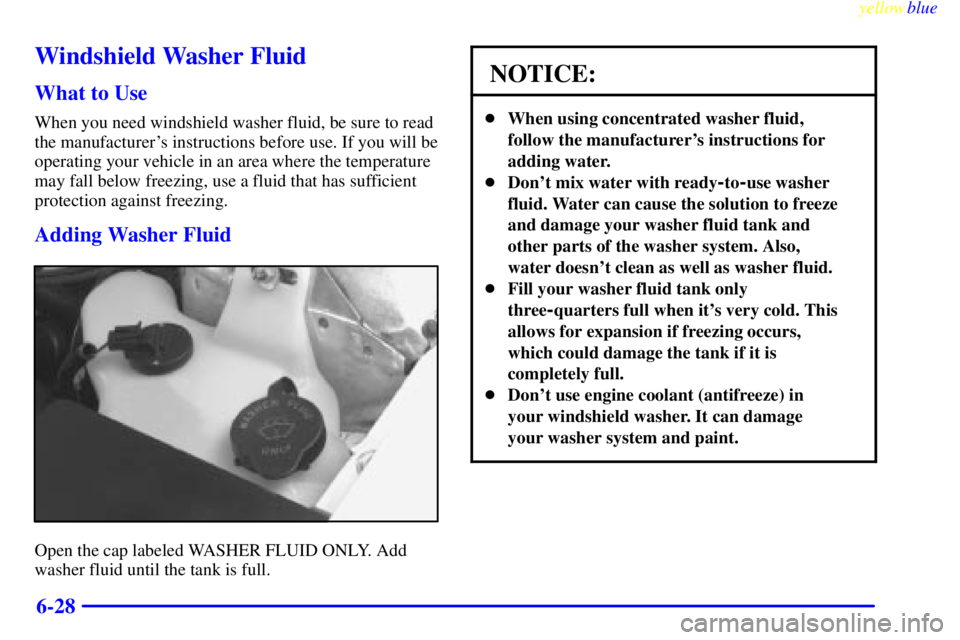Page 275 of 392

yellowblue
6-25 What to Use
Use a mixture of one-half clean, drinkable water and
one
-half DEX-COOL� coolant which won't damage
aluminum parts. If you use this coolant mixture, you
don't need to add anything else.
CAUTION:
Adding only plain water to your cooling system
can be dangerous. Plain water, or some other
liquid like alcohol, can boil before the proper
coolant mixture will. Your vehicle's coolant
warning system is set for the proper coolant
mixture. With plain water or the wrong mixture,
your engine could get too hot but you wouldn't
get the overheat warning. Your engine could
catch fire and you or others could be burned. Use
a 50/50 mixture of clean, drinkable water and
DEX
-COOL� coolant.
NOTICE:
If you use an improper coolant mixture, your
engine could overheat and be badly damaged.
The repair cost wouldn't be covered by your
warranty. Too much water in the mixture can
freeze and crack the engine, radiator, heater core
and other parts.
If you have to add coolant more than four times a year,
have your dealer check your cooling system.
NOTICE:
If you use the proper coolant, you don't have to
add extra inhibitors or additives which claim to
improve the system. These can be harmful.
Page 276 of 392
yellowblue
6-26 Checking Coolant
The vehicle must be on a level surface. When your
engine is cold, the coolant level should be at the FULL
COLD mark or a little higher. When your engine is
warm, the level should be up to the FULL HOT mark or
a little higher.
If this LOW COOLANT
warning light comes on and
stays on, it means you're
low on engine coolant.
Adding Coolant
If you need more coolant, add the proper DEX
-COOL�
coolant mixture at the coolant recovery tank, but be
careful not to spill it.
CAUTION:
Turning the radiator pressure cap when the
engine and radiator are hot can allow steam and
scalding liquids to blow out and burn you badly.
With the coolant recovery tank, you will almost
never have to add coolant at the radiator. Never
turn the radiator pressure cap
-- even a
little
-- when the engine and radiator are hot.
Page 277 of 392

yellowblue
6-27
CAUTION:
You can be burned if you spill coolant on hot
engine parts. Coolant contains ethylene glycol,
and it will burn if the engine parts are hot
enough. Don't spill coolant on a hot engine.
Power Steering Fluid
The power steering fluid reservoir is located on the rear
passenger side of the engine compartment.
When to Check Power Steering Fluid
It is not necessary to regularly check power steering
fluid unless you suspect there is a leak in the system or
you hear an unusual noise. A fluid loss in this system
could indicate a problem. Have the system inspected
and repaired.
How to Check Power Steering Fluid
When the engine compartment is cool, wipe the cap and
the top of the reservoir clean, then unscrew the cap and
wipe the dipstick with a clean rag. Replace the cap and
completely tighten it. Then remove the cap again and
look at the fluid level on the dipstick.
The level should be at the FULL COLD mark. If
necessary, add only enough fluid to bring the level up to
the mark.
What to Use
To determine what kind of fluid to use, see
ªRecommended Fluids and Lubricantsº in the Index.
Always use the proper fluid. Failure to use the proper
fluid can cause leaks and damage hoses and seals.
Page 278 of 392

yellowblue
6-28
Windshield Washer Fluid
What to Use
When you need windshield washer fluid, be sure to read
the manufacturer's instructions before use. If you will be
operating your vehicle in an area where the temperature
may fall below freezing, use a fluid that has sufficient
protection against freezing.
Adding Washer Fluid
Open the cap labeled WASHER FLUID ONLY. Add
washer fluid until the tank is full.
NOTICE:
�When using concentrated washer fluid,
follow the manufacturer's instructions for
adding water.
�Don't mix water with ready
-to-use washer
fluid. Water can cause the solution to freeze
and damage your washer fluid tank and
other parts of the washer system. Also,
water doesn't clean as well as washer fluid.
�Fill your washer fluid tank only
three
-quarters full when it's very cold. This
allows for expansion if freezing occurs,
which could damage the tank if it is
completely full.
�Don't use engine coolant (antifreeze) in
your windshield washer. It can damage
your washer system and paint.
Page 321 of 392
yellowblue
6-71 Vehicle Dimensions
Wheelbase 110.8 inches (281.4 cm). . . . . . . . . . . . . .
Tread Width . . . . . . . . . . . . . . . . . . . . . . . . . . . . . . . .
Front 60.4 inches (153.4 cm). . . . . . . . . . . . . . . . . .
Rear 60.3 inches (153.2 cm). . . . . . . . . . . . . . . . . . .
Length 201.9 inches (512.8 cm). . . . . . . . . . . . . . . . .
Width 74.6 inches (189.5 cm). . . . . . . . . . . . . . . . . . .
Height 55.7 inches (141.5 cm). . . . . . . . . . . . . . . . . . .
L36 Engine Accessory Belt
The L36 engine uses an engine accessory belt. This
diagram shows the features connected and the routing.
See ªMaintenance Scheduleº in the Index for when to
check the belt.
A. Power Steering
B. Generator
C. Air ConditioningD. Crank
E. Coolant Pump
F. Idler
Page 322 of 392
yellowblue
6-72 L67 Engine Accessory Belt
The Supercharged 3800 (L67) engine uses two
accessory drive belts. The inner belt drives the
generator, power steering pump, coolant pump and air
conditioning. The outer belt drives the supercharger.
Each belt has its own tensioner and idler pulley. See
ªMaintenance Scheduleº in the Index for when to check
the accessory drive belts and the supercharger oil level.
Have your dealer check the oil level in the supercharger.
1. Front Belt
2. Back Belt
A. Generator
B. Power Steering PumpC. Crank
D. Supercharger
E. Coolant Pump
F. Air Conditioning
Page 343 of 392
Short Trip/City Scheduled Maintenance
yellowblue
7-21
�Change automatic transaxle fluid and filter if the vehicle is mainly driven
under one or more of these conditions:
± In heavy city traffic where the outside temperature regularly reaches 90�F
(32�C) or higher.
± In hilly or mountainous terrain.
± When doing frequent trailer towing.
± Uses such as found in taxi, police or delivery service.
�If you haven't used your vehicle under severe service conditions listed
previously and, therefore, haven't changed your automatic transaxle fluid,
change both the fluid and filter.
150,000 Miles (240 000 km)
�Drain, flush and refill cooling system (or every 60 months since last service,
whichever occurs first). See ªEngine Coolantº in the Index for what to use.
Inspect hoses. Clean radiator, condenser, pressure cap and neck. Pressure test
cooling system and pressure cap.
An Emission Control Service. ACTUAL
SERVICED BY:MILEAGE
DATE
Page 353 of 392
Long Trip/Highway Scheduled Maintenance
yellowblue
7-31
150,000 Miles (240 000 km)
�Drain, flush and refill cooling system (or every 60 months since last service,
whichever occurs first). See ªEngine Coolantº in the Index for what to use.
Inspect hoses. Clean radiator, condenser, pressure cap and neck. Pressure test
the cooling system and pressure cap.
An Emission Control Service.ACTUAL
SERVICED BY:MILEAGE
DATE